Last updated Dec 31, 2006
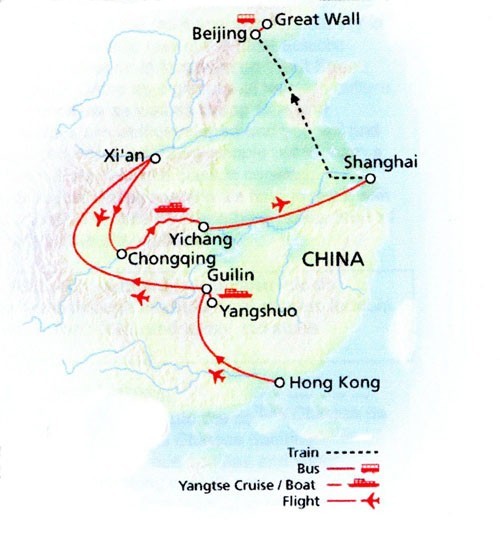
| Go to |
Last updated Dec 31, 2006 |
||
| Hong Kong | |||
| China - Start |
 |
||
| Yangshuo | We left home on April 10, arriving in Hong Kong on April 11 after a 12 hour flight on which we were able to catch up on our movie watching, if not our sleep. We spent 6 days on our own in Hong Kong before joined our tour group for two weeks in China on the Imaginative Traveller's "China in Style" tour. And Boy was it in Style! We could get used to staying in and hotels. | ||
| Xi'an | |||
| Yangtze River | |||
|
Shanghai | ||
| Beijing | |||
| Breakfast was included daily and was usually a beautiful western style buffet. The rest of the meals on the tour were Chinese and we were never even offered western cutlery. Fortunately we had practiced using chopsticks and were fine. We had heard bad things about the food in China but everything we had was great. In fact, too good. So much for our plan to lose weight on a rice diet. | |||
| There were only six of us and a tour leader on the tour: us, another Canadian couple (from Vancouver) and a couple from Liverpool, England. Our tour leader was Neil, a young fellow from Manchester, England. | |||
| We generally flew between cities and were always met at the airport by a local guide and driver who would stay with us the entire time we were in the city. | |||
| The tour ended in Beijing and we returned to Hong Kong for one night before coming home, arriving here on May 2. | |||
| Hong Kong | ||||||
|
Hong Kong is an amazing city. It was very clean and felt safe, at least on the sidewalks. In Edmonton, pedestrians have the right of way. In Hong Kong, (and all of China for that matter) pedestrians have the right to get run over. It is a night city - the stores didn't open until 10 (or later) and didn't close until 10 or 11 and the streets were busier at midnight than they were at noon. Our hotel was in Kowloon, across the harbour from Hong Kong city, about a ten minute walk from the water-front. All the way down to the harbour, we were constantly accosted by men offering "Copy watch?" or "Suit, sir?" |
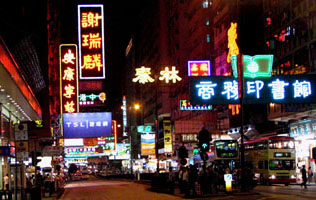 |
|||||
|
|
||||||
| Buildings and Street scenes |
Hong Kong went on a building
spree in the late 1900s and has some of the most amazing sky-scrapers in
the world. It has massive new apartment complexes but also has some
interesting older ones right beside them. The streets are an
interesting mix of the old and the trendy. Our hotel overlooked Kowloon Park, some of the city's precious green space. |
|||||
| Victoria Harbour |
Every night there was a
light show of the buildings along both sides of the harbour. It was
set to music and lasted for about 15 minutes. We enjoyed it so much
that we went back three times. We took a boat tour of the harbour on a Junk operated by the Hong Kong tourist authority. It is the last genuine Junk in operation there. |
|||||
| Victoria Peak | We took the bus up to the lookout at the top of Victoria Peak and then walked around the peak (about a one hour walk that took us over two hours due to the number of photo ops. You are being spared most of them.) We took the tramway back down which was an experience - it is pulled by steel cables up and down a 27° grade. | |||||
| Temples and Churches |
Hong Kong has all religions
well represented. We took a day to go to the Po Lin Monastery on
Lantau Island. It is the home to the world's largest sitting Buddha,
a bronze-cast statue over 34 metres high. They are currently
building a cable car from Tung Chung, the end of the train/subway system,
to the monastery but until it is complete, you take a one hour bus ride up
and down a hilly road which is mostly one lane wide with "passing places".
We visited a number of Taoist Temples in various places around Hong Kong, including a mock-up one in the Hong Kong History Museum. Because we were going to be in Hong Kong for Easter, we checked out the Anglican Cathedral. However, their 11 am service was going to be in Filipino so we opted for an Anglican church we found just a block from our hotel. |
|||||
| Aberdeen | We took the bus to Aberdeen on the south side of Hong Kong Island as it is the last place to still have a number of sampans in the harbour. While there we had lunch in a floating restaurant, then went over to Stanley to visit their market. | |||||
| Everything Else | Museums, our hotel, people on the streets, etc. | |||||
| China | |||||||||||
|
We joined up with our tour
group for dinner on our last night in Hong Kong. It was a good
chance to meet each other and we knew right away that we were going to get
along.
The next morning we took a ferry from Hong Kong to Shenzhen where we went through Chinese Immigration. Then we took a plane from Shenzhen to Guilin for the real start of our China Tour. |
|||||||||||
| Guilin and the Li River | Guilin [g-way-lin] is on the Li River, in a area famous for its "Karst" formations - hills of limestone that have eroded into discrete bumps rather than the rolling hills familiar in the rest of the world. |
|
|||||||||
|
Our hotel was in the centre of Guilin, on the edge of Banyan Lake which was surrounded by a beautiful park. It was late afternoon by the time we got there so there was only time for a quick stroll around the lake before dinner. The next morning we took a four hour cruise down the Li River to Yangshuo, passing through some of the most amazing scenery of the trip. |
|||||||||||
| Yangshuo | Yangshuo is a small city of about 30,000 located in the heart of the rice paddy area about an hour's drive from Guilin. It is very popular with both western and Chinese tourists because it shows the old China. The Chinese tourists also come to see the Westerners. | ||||||||||
|
After getting off the cruise boat, we went around the
corner to our hotel, checked in and went exploring. There were
souvenir stalls lining the street in front of the hotel, and at the corner was the start of West Street, the main tourist street in town.
Neil gave us our first lesson in negotiating before we set out. Secret - you don't. You ask how much, express horror at the amount and walk away. DO NOT give them a price as the price you would come back with would still be way too high. They will try another price. You say that is too much and start walking again. They will come back with ANOTHER price. When they are getting close to what you might pay, you can give them a price. We went to a little classroom on a backstreet where a man gave us a one-hour lesson in Chinese. The main thing we got out of it was the numbers from 1 - 10, 20,30 etc and 100, 200, etc and the corresponding hand signals. They were useful in our subsequent shopping. We spent three days in Yangshuo, shopping and sightseeing. |
|||||||||||
| Light Show | In the evening, we went to a music and light show which told the story of a young girl setting off for her marriage to a man in another area, across the sea. The show took place on the Dragon River, a Li River tributary, and was done entirely on the water using barges and the little bamboo rafts we had seen earlier on the river. There was a cast of over 600 people. |
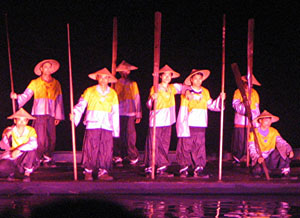 |
|||||||||
| Caves | The same limestone that has created the Karst hills has also created some incredible caves. We visited one on a rainy morning. One of the most interesting parts of the visit was the signs on the walkway. Here they are along with a couple of other signs we saw on our China trip. | ||||||||||
| Means | |||||||||||
|
|
||||||||||
| Biking | Yangshuo is know for its bike tours into the countryside where you can still see the farmers tilling their samll plots of land with water buffalo and planting the rice by hand. Other areas of China are moving to the larger, mechanized farms similar to ours. Although we went on the road, it was fairly safe as there are very few motor vehicles in the area. | ||||||||||
| The rest | There are three sets of pictures here: assorted pictures from the streets of Yangshuo, pictures from Pu Yi, a country village where we stopped to wander around and pictures from LiuGong [Lee u gong], a semi-deserted village from the Ming Dynasty where we had dinner. In Pu Yi, we found a man making rice whiskey in his still so we bought a water bottle's worth for 2 yuan. We also saw a lady making aprons. She wanted 20 yuan each for them - we got her down to 3 for 20. (7 yuan to the Canadian $) | ||||||||||
| We left Yangchuo by bus late in the day to return to the Guilin airport and flew Hainan Airlines to Xi'an where we spent two nights. | |||||||||||
| Return to Top | |||||||||||
| Xi'an | |||||||||||
|
Xi' an [She-ann],
a city of 7.5 million, is now famous
for its Terracotta Warriors, a pottery army of 7,000 life-sized soldiers
and horses build in about 200 BC to guard the mausoleum of Emperor Qin,
the first Emperor of all of China. Emperor Qin also built much
of the Great Wall across China's northern
border.
Xi'an has a long history. It was the capital of China for over 1000 years (from the Qin Dynasty until the end of the Tang Dynasty, 10th century AD) and was the start of the ancient Silk Road linking China to Europe. As a result of the silk trade, there is a very large Muslim population there. We went to see the warriors first thing in the morning, then spent time seeing the rest of the city. |
|||||||||||
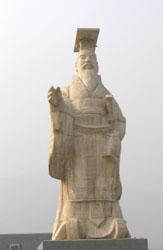 Emperor Qin |
Terracotta Warriors | The Terracotta Warriors were only discovered in 1974 which is how they survived the Cultural Revolution of the 1960s. Three pits have been found to date. The first and largest has over 6,000 warriors : columns of foot soldiers in front, followed by war chariots at the back. | |||||||||
|
The second pit has over
1,000 warriors and 90 chariots. The third pit has only 68 warriors,
one chariot and four horses and appears to have been
the command headquarters.
Interestingly, there are no generals in the command centre, only out with
the army. Apparently Emperor Qin distrusted the generals and was
afraid they would attempt to overthrow him if they were allowed to be
actually part of the army command.
We went to all three pits, and then to the museum where there was a display of art from the period and there was a bronze funeral chariot which had been found near the pits and was believed to have been a copy of the one used for Emperor Qin. |
|||||||||||
| Only one of all the warriors was found intact. The rest are being pieced together by teams of archeologists. When the pits were first opened, the figures were brilliantly painted. However, within a hour of exposure to the air, the colours faded. The museum has painted replicas to show what they were originally like. | |||||||||||
| Temples | After our visit to the Terracotta Warriors, we visited the Ba Xian'an Monastery (a Taoist Temple), the Xi'an Great Mosque (an 8th century Mosque which didn't look like any mosque we had ever seen) and the Da Ci'en Temple (a Buddhist Temple dating from the 6th century) which includes the Dayan (Big Goose) Pagoda which was built in 648 AD and restored in 704 AD. We climbed the 7 storey pagoda for a view of the city. | ||||||||||
| City Scenes |
That evening we went to a
Dumpling Dinner and a Tang Dynasty Cultural Evening - songs, dancing and
musical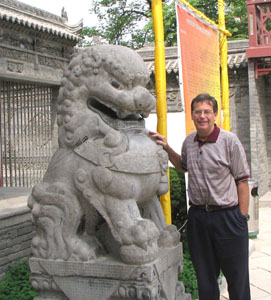 instruments from the Tang Dynasty (618-907 AD).
The next morning we went into central Xi'an. The city wall was built
in the Ming Dynasty (1368-1644) and is one of
the few intact city walls in China. We took a ride on the wall from the South
Tower to the East Tower of the wall, then grabbed a cab to the Drum and
Bell Towers in the centre of the old city. They were also built in
the Ming Dynasty when a pair was built in every major city. Again,
these are among the best preserved in China. After visiting them, we
returned to the hotel to check out.
instruments from the Tang Dynasty (618-907 AD).
The next morning we went into central Xi'an. The city wall was built
in the Ming Dynasty (1368-1644) and is one of
the few intact city walls in China. We took a ride on the wall from the South
Tower to the East Tower of the wall, then grabbed a cab to the Drum and
Bell Towers in the centre of the old city. They were also built in
the Ming Dynasty when a pair was built in every major city. Again,
these are among the best preserved in China. After visiting them, we
returned to the hotel to check out.Sunday is a big day for weddings in China. There were 7 in our hotel alone! Most have lunch-time receptions rather than evening ones and one had taken over the lobby of the hotel. We tried to sneak some pictures but were noticed and treated to a congratulatory shot of rice whiskey and pictures with the bride and groom. |
||||||||||
| Following our wedding crashing, we went to the airport where we caught a Sichuan Airlines flight to Chongqing [Chong Ching], the starting point for our Yangtze River Cruise. | |||||||||||
| Return to Top | |||||||||||
| Yangtze River Cruise | We arrived in Chongqing in late afternoon, just time for a quick city tour and dinner before boarding our ship for our Yangtze River Cruise. Chongqing is a city of 3.9 million or 6.5 million or 12.1 million, depending on your source, making it a major centre - and we have never heard of it! It is actually a "provincial-level municipality" with a total population of 32.4 million. It is a major industrial area with coal mining, steel manufacturing, an automotive industry, cement and fertilizer manufacturing, etc. | ||||||||||
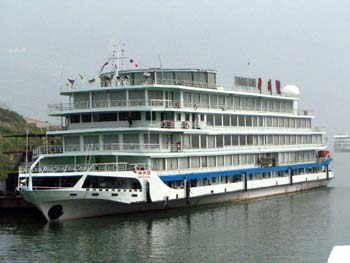 We
boarded the ship after dinner but remained docked until the next morning
when we started the cruise. We were assigned a table for 12 in the
dining room where we were joined by Pam and Eric Taylor, a couple from
Australia who were on a private tour quite similar to ours, and Hock and
Christina Lim and their teenage son Jonathan, a Chinese family from
Australia, originally from Malaysia, who were exploring their ancestral
roots. We shared all our meals together and enjoyed their company
for the three days. We
boarded the ship after dinner but remained docked until the next morning
when we started the cruise. We were assigned a table for 12 in the
dining room where we were joined by Pam and Eric Taylor, a couple from
Australia who were on a private tour quite similar to ours, and Hock and
Christina Lim and their teenage son Jonathan, a Chinese family from
Australia, originally from Malaysia, who were exploring their ancestral
roots. We shared all our meals together and enjoyed their company
for the three days.
The first morning, we had a briefing about the ship's features, the Yangtze River and the Dam project. This was followed by the Captain's Welcome Party complete with champagne (at 11:00 am!) and appetizers. After lunch there was a demonstration on painting the insides of bottles. They also showed us how to tell the difference between the hand done ones and the laser, mass produced ones. I couldn't see enough difference to pay for the original so eventually (in Beijing) bought a fake. In between the formal activities, we watched the scenery going by. We thought it was just overcast until we realized that the haze had a yellow tinge to it - we were seeing some of the world's worst smog. The whole Yangtze River area is filled with heavy industry and no pollution controls! |
|||||||||||
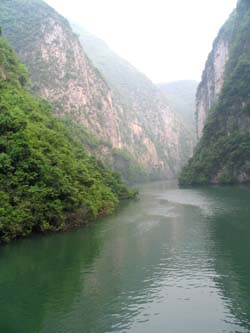 In
the afternoon, we went ashore at Fengdu to visit the nearby temples and
Ghost City. That evening we had a fashion show and a show of
"ethnic" costumes and dances, i.e. from various regions of China. In
the afternoon, we went ashore at Fengdu to visit the nearby temples and
Ghost City. That evening we had a fashion show and a show of
"ethnic" costumes and dances, i.e. from various regions of China.
The next day was raining/drizzling so we had a limited view of the Three Gorges as we passed through them. They were inspiring but nothing compared to what they were before the flooding started. After lunch we took an excursion down the Shennong River, one of the tributaries feeding into the Yangtze River. We took a ferry for about an hour upstream, then transferred to 12 passenger flatboats to go up the shallows. This river also has beautiful, narrow gorges which gave us a feel of what the Yangtze must have been before the flooding. Fortunately, the weather was clearing through the day so we had a lovely trip. We returned to the ship to the "Captain's Farewell Banquet". Even a three night cruise has to have all the formalities! |
|||||||||||
|
At 8:30 that evening, we
arrived at the top of the Three
Gorges Dam and entered the first lock to go down to the
bottom. Currently there are four locks. A fifth one will be
built as the flooding raises the river the remaining 30 metres. It
took about 1 1/2 hours to load us and six more ships into the top lock.
Once we were all in, we went down about 30 metres and moved out into the
next lock. We all moved together so the movement from lock to lock
was quite quick. However, it still took nearly 4 hours to get to the
base.
While we were moving through the locks, there was a talent show in the lounge for both staff and passengers. After breakfast the next morning we left the ship for our tour of the dam. After touring the dam site, we drove to Yichang City for lunch. While there, we stopped in an embroidery factory, our one and only "factory" stop of the entire trip: and I was the only buyer! We crashed another wedding at the restaurant where we had lunch - this time, we actually went through the receiving line. After lunch, we caught a China Eastern Airlines flight to Shangai. |
|||||||||||
| Click here for Yangtze River Cruise Pictures | |||||||||||
| Return to Top | |||||||||||
| Shanghai | Our plane was early arriving in Shanghai and our guide wasn't there yet. While Neil went off to see if | ||||||||||
|
he was around somewhere, we
stood around looking foreign. Fortunately we knew that Neil's other
name was Patricia (long story) so, when we saw someone going by with a
"Patricia" sign, we nabbed him.
A highlight of the Shanghai stop was going to be a visit to the Shanghai Acrobats. There should have been time for us to go for dinner first but the driver was new and got lost. After an hour of listening to an animated discussion between the guide and the driver, Neil intervened and said just take us to the theatre. There, we enjoyed a wholesome dinner of popcorn and ice cream bars before the show started. |
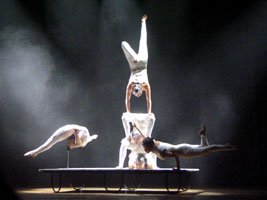 |
||||||||||
| Following the wonderful acrobat show, we checked into our hotel, Shanghai's famous Peace Hotel. It is located on the river bank, in the old section of downtown Shanghai, an area of buildings from the 1920s which have been restored to their original splendor. Directly across the Huang Pu River was the new downtown with the modern skyscrapers. Our room was spectacular! (pictures of the Hotel) We went out for a walk on the Bund, the sidewalk/boulevard along the edge of the river to enjoy the lights before retiring for the night. Note: Shanghai is located on the south side of the Yangtze River Delta and is divided by the Huang Pu River, a tributary of the Yangtze River. You can't actually see the Yangtze Delta from where we were. | |||||||||||
| The next morning, after a fabulous buffet breakfast in the 8th floor dinning room overlooking the river, we went back out onto the Bund to look at the buildings by day and our guide pointed out buildings of historic significance. (Bund pictures - by night and by day) | |||||||||||
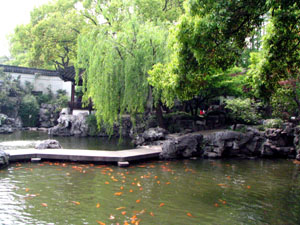 |
Then we went to
the Jade Buddha Temple, home of two priceless Buddhas brought to Shanghai
from Burma in 1882. The Sitting
Buddha is 190 centimetres high and encrusted by agate and emeralds.
The Recumbent Buddha is 96 centimeters long. Each one is carved from a
single piece of white jade. There are enlarged copies in the main temple but
the real ones were also on display so we were able to see them too.
(Temple Pictures) After lunch, we went to the Yuyuan Gardens (meaning Garden of Peace and Comfort), designed four hundred years ago in the Ming Dynasty. The garden had over 30 pavilions linked by a maze of corridors and bridges over ponds. Ancient trees and sculptures inside this garden were encircled by an undulating dragon wall. While there, we listened to a women's orchestra playing ceramic instruments from the 16th century. They played a variety of traditional Chinese melodies plus - Ready? - March of the Toreadors from Carmen! (Yuyuan Garden Pictures) We finished our Shanghai visit with some shopping. We learned that the magic words to stop negotiations were "I can get it for $$$ in Hong Kong!" |
||||||||||
|
Our overnight train for Beijing was leaving at 7:00 so, rather than stop early for dinner, we got take-out and ate in the train station before boarding our train. We had sleeper compartments, four to a compartment. We shared with Hilda and Gary. Karen, Nick and Neil shared their compartment with a Chinese gentleman who went straight to bed. |
|||||||||||
| Click here for the rest of our Shanghai pictures | |||||||||||
| Return to Top | |||||||||||
| Beijing | |||||||||||
Our train arrived in Beijing at 7:00 where we were met
by Pat, our guide for the next few days. We stopped for breakfast at
a little doughnut shop across the street from Tiananmen Square before
joining the crowds of Chinese people in the square. Mao's
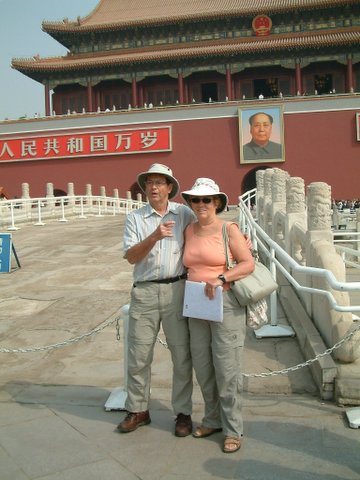 tomb is in
the square and Gary went there while the rest of us wondered around the 44
hectare site. Then we regrouped and went into the Forbidden City.
It is across a busy street from the square but there is a pedestrian
underpass so they don't lose too many tourists to the traffic. tomb is in
the square and Gary went there while the rest of us wondered around the 44
hectare site. Then we regrouped and went into the Forbidden City.
It is across a busy street from the square but there is a pedestrian
underpass so they don't lose too many tourists to the traffic.
The Forbidden City was build by one million workers between 1406 and 1420 when the 3rd Ming Emperor moved his capital from Nanjing to Beijing. It was the home of the Emperor from the Ming Dynasty until 1924. It has been open to the public since 1925. The Forbidden City has 9999 rooms in a maze of interconnected buildings and halls covering 77 hectares (about 200 acres) . The Outer Court's halls and courtyards were where the Emperor met with officials and the public while the Inner Court was the residence of the Emperor and his court. We toured the main areas as a group, then split off to see it on our own. We paid extra to get into a jewelry exhibit which took us into the back areas of the residences and away from the crowds. Our Guide told us that the Forbidden City survived the Cultural Revolution because the head of the regular army claimed it for his headquarters and moved his troops into it as their barracks. The Red Guard (the part of the army destroying anything historic) was unable to destroy it without first relocating the army. And who says that Bureaucracy isn't good for anything! About half of the Forbidden City has been restored and repainted and the rest will be done before the Olympic in 2008. In fact all of Beijing is being spruced up, meaning that there were a lot of buildings off limits to us on our visit. |
|||||||||||
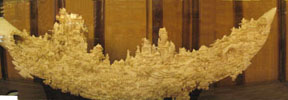 |
We checked into our our hotel, the Grand Hotel, and was it GRAND. This was five-star luxury at its finest. After a shower and changing, we had a late lunch and went to the Temple of Heaven. | ||||||||||
|
The
Temple of
Heaven was a bit of a disappointment as the main temple and
surrounding grounds were not open: it was being renovated for the
Olympics. Actually, most of Beijing is being renovated.
After our visit to the Temple of Heaven, Neil took us to "Silk Street", which was actually a six-story building full of stalls selling clothing and Chinese souvenirs. It was a real zoo with people calling at you and pulling you to their stalls as you went buy. Prices started out at as much as 10 times what they really expected you to pay but as you walked by, they would be coming down. Eventually, we gave up and went back to the hotel by subway to join the rest of the group for dinner in the lake area where the nightlife was. Dinner was incredibly cheap and excellent. Karen went into a tea shop where she tasted teas for an hour while the rest of us wandered around. She was able to give us instructions on buying tea when we met up again although we didn't have time until we were back in Hong Kong. |
|||||||||||
|
The next morning, after the
very best buffet breakfast to date (and we thought the one at the Peace
Hotel would be hard to match!), we took a taxi to the Bell and Drum Towers
and walked around the block to the rickshaw stand. The Hutong district is an area of narrow streets with houses and shops that are over 400 years old, (the Ming dynasty). Hilda and Gary's driver spoke English and served as the tour guide for the group. We visited one of the homes and met a couple whose family had lived in the house for 115 years. We then stopped in a market for a look. That afternoon we went to the Summer Palace. It was built in the Jin Dynasty (1115-1234), extended continuously and by the Qing Dynasty (1644-1911), it had become a luxurious royal garden for the royal families. However, much of what is there today was rebuilt or renovated under the Empress Dowager Cixi who ruled China as regent till her death 1908. Find out more about her at Cixi |
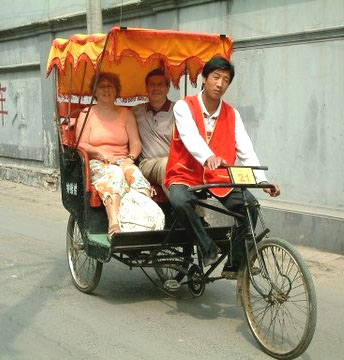 |
||||||||||
| That evening, we went to the famous Beijing Opera. It was a once in a life-time, must-see experience, which is a tactful way of saying we were glad we went but we wouldn't go back. | |||||||||||
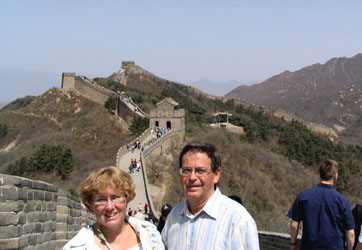 |
The next morning it was off
to the Great Wall. It is an hour drive out of town to get to one of
the more popular sections of the wall. The section was packed and we
could only go for a couple of miles in any direction as the wall has many
breaks - areas where the wall has crumbled and not been repaired.
The Great Wall was started by Emperor Qin (yes, the Terra Cotta
Warrior Guy) in 200 BC and extended/ repaired/ rebuilt by the Mings
(1400s) As you can see from the pictures, it goes on, and on, and on... Because it winds along, you can look in any direction and see it. |
||||||||||
|
We stopped along the highway
for a late lunch at a tour bus stop. The food was fine and the shopping
was interesting. Everything there was fixed price and 3 or 4 times
what we had gotten things for at Silk Street. Then we returned to
Beijing for a visit to the
Ming Tombs.
We walked the Sacred Way which was where the funeral processions would go,
then stopped in a little museum at the tombs and went into one. I
haven't put captions on the pictures but there are several signs that we
copied into the pictures that explain them. Based on our experience in the tour bus store, we had our driver drop us back at the subway and went to Silk Street for some more shopping before dinner. Again the magic words "I can get it for $$$ in Hong Kong!" helped speed up negotiations a couple of times. (But only if it was true!) Dinner was going to be Peking Duck. Neil gave us our choice of a restaurant with tourist ambience or local cuisine. We opted for the local cuisine so he took us down some back streets and into a basement restaurant where we were the only Caucasians. The food was fabulous and the bill came to a whole $23 cdn for the 7 of us! Back at the hotel, we had a final farewell drink as we were all leaving separately in the morning. Last Pictures |
|||||||||||
|
The next morning, we had an
early wake-up call for our drive to the airport and our 7:30 am flight to
Hong Kong. There, we headed back out to Stanley for some last minute
shopping, then returned to town and strolled around until bedtime.
We just had time to have breakfast and repack before heading back to the
airport for our flight home. We arrived home on May 2 full of wonderful memories and ready to go again (after a little nap...) |
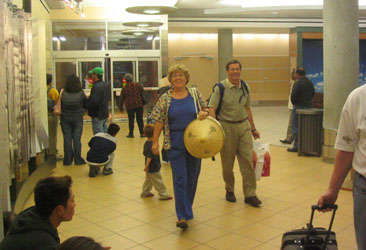 |
||||||||||
| Return to Top | |||||||||||
| An invaluable source of more detailed information on the places we visited on our trip was www.travelchinaguide.com | |||||||||||
Back to Ruth and Allen's home page
| If you have any questions, comments or problems with this web site, please send an e-mail to |
| webmaster at thebenbows.ca |
| Caution: Reply may be slow - the webmaster doesn't check for mail very often. |
Visitors